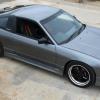Help Understand GTT Boost Setup
Announcements
-
Similar Content
-
Latest Posts
-
By joshuaho96 · Posted
Atmospheric vent requires something that doesn't use a MAF for load. You would need a standalone ECU for that. -
By drifter17a · Posted
Hey all, I’ve got an RB25 with a trigger kit that includes a crank wheel, and I’ve hit a wall trying to sort a timing belt tracking issue. The belt either rides right on the edge of the cam/crank pulleys or walks slightly forward once the engine starts. It tracks okay-ish for a moment, then creeps right to the edge—and honestly, it’s stressing me out. I’ve spent hours removing and reinstalling the belt, double-checking everything: Tensioner setup is good, checked multiple times Idler pulley and washers are all in the correct places Followed the RB25 timing procedure step-by-step The only thing I changed was the rear crank washer—I swapped the OEM one for a Neato version, and it made things worse. The belt now sits even more forward than before. I’m beginning to think the crank trigger wheel itself (from the trigger kit) is the issue—poor design or slightly off dimensions. What’s strange is that with the previous belt setup, it actually ran fine for a couple of years—around 4,000 to 5,000 miles, even with hard driving and high RPMs. But even then, the belt was always riding right on the edge, and I know that’s not ideal or safe long term. At this point, I’m debating whether to: Machine a few mm off the crank trigger wheel to bring it back in line, or Replace it entirely with a better-designed unit Only thing is, I already have the Cherry Hall sensors, bracket, etc.—I just want to replace the wheel only, not the entire kit. Anyone know a brand or supplier that sells just the crank trigger wheel on its own? Would really appreciate any feedback—especially from anyone who’s run into this exact issue and found a reliable fix. Thanks in advance. -
Hi...a little refresh. Is Nistune gonna be enough to run BoV? Or do i need some proper ECU?
-
Yep that's pretty much what I want to see. Racecars that look and sound like the Group A but with newer tech underneath to make them faster and safer. I'm sure there's enough VK-to-VN commodore, E30 BMWs and Foxbody mustangs shells around to make up a decent number of cars with hopefully a couple of sierras, rx7 and R31s in there too.
-
By robbo_rb180 · Posted
Contact Jessestreeter.com/Skevas Racing/JustJap for a new r34 rb gearbox or go a cd00# conversion. No point playing with unknown condition gearboxes.
-





Recommended Posts
Create an account or sign in to comment
You need to be a member in order to leave a comment
Create an account
Sign up for a new account in our community. It's easy!
Register a new accountSign in
Already have an account? Sign in here.
Sign In Now